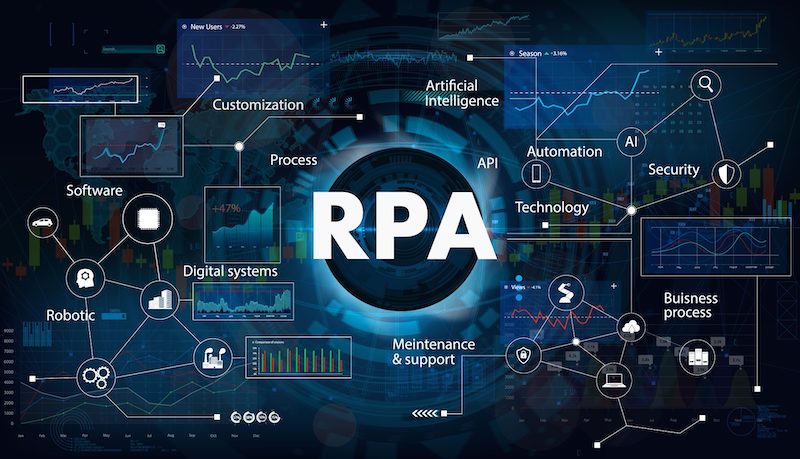RPA and Intelligent Automation possess the potential to transform your company’s operations, improving effectiveness, output, and time-to-market.
Instead of displacing human workers, they aim to nurture a more efficient hybrid workforce that melds human skills with digital capabilities – a concept we refer to as “human+”.
This integrated strategy magnifies your organization’s human potential and delivers significant cost savings and time optimization.
However, the question remains: how do you determine the right solution to adopt?
To optimize your business processes through cutting-edge automation solutions, consider IT outsourcing services by Reenbit. Reenbit specializes in Intelligent Automation (IA) services, which we’ll explore in-depth in this article.
Let’s compare Robotic Process Automation (RPA) and Intelligent Automation (IA).
What is Robotic Process Automation (RPA)?
Robotic Process Automation (RPA) is a groundbreaking technology that employs software robots to automate repetitive and rule-based tasks within business processes.
It has gained immense popularity due to its ability to significantly enhance operational efficiency. A recent study by Deloitte found that RPA implementation can lead to an impressive 40-80% reduction in processing time for various tasks, leading to substantial cost savings and improved productivity for organizations.
Benefits of Robotic Process Automation
- Increased Efficiency: RPA automates repetitive tasks, allowing processes to be completed much faster and with fewer resources.
- Reduced Errors: RPA eliminates the risk of human error in tasks, ensuring a higher degree of accuracy in data processing and decision-making.
- Cost Savings: By automating routine and time-consuming tasks, RPA reduces operational costs, including labor expenses, and enables organizations to allocate resources more effectively.
- Faster Processes: RPA accelerates processes by working around the clock without breaks, leading to quicker task completion and improved response times.
- Scalability: RPA solutions can easily adapt to changing workloads, making it simple for organizations to scale their automation efforts as needed.
- Enhanced Compliance: RPA ensures strict adherence to regulations and compliance standards, reducing the risk of penalties and legal issues.
- Data-Driven Insights: RPA provides valuable data analytics and insights, helping organizations make informed decisions and optimize their operations.
- Empowered Workforce: By handling repetitive tasks, RPA allows employees to focus on more meaningful, creative, and strategic work, leading to a more engaged and productive workforce.
- Improved Customer Service: RPA enables faster and more accurate responses to customer inquiries and requests, resulting in enhanced customer satisfaction and loyalty.
- Competitive Edge: Organizations that embrace RPA gain a competitive advantage by being more agile, responsive, and efficient in a dynamic business environment.
Robotic Process Automation (RPA) in Healthcare
Robotic Process Automation (RPA) has gained significant traction in healthcare. It offers the potential to streamline administrative tasks, reduce errors, and improve overall efficiency in healthcare organizations.
RPA can be applied to various processes, such as patient data management, billing, and claims processing, ultimately allowing healthcare professionals to focus more on patient care.
Limitations of RPA
While RPA offers numerous advantages, it is essential to acknowledge its limitations:
- Limited Cognitive Abilities: RPA cannot handle tasks that require complex decision-making or emotional intelligence.
- Integration Challenges: Integrating RPA with legacy systems can be complex and costly.
- Security Concerns: Bots may pose security risks if not adequately configured and monitored.
What is Intelligent Automation (IA)?
Intelligent Automation (IA) integrates artificial intelligence (AI), machine learning, and robotic process automation to develop intelligent business processes and workflows with autonomous thinking, knowledge, and adaptability.
Benefits of Intelligent Process Automation
- Enhanced Efficiency: Intelligent Process Automation (IPA) streamlines and accelerates repetitive tasks, reducing manual effort and human error.
- Improved Accuracy: IPA ensures higher accuracy in data handling and decision-making, minimizing mistakes and associated costs.
- Cost Savings: Organizations can significantly reduce operational costs and strategically allocate resources by automating routine processes.
- Faster Turnaround: IPA enables quicker completion of tasks, leading to shorter response times and improved customer satisfaction.
- Scalability: Automation solutions can quickly adapt to changing workloads, allowing organizations to scale their operations efficiently.
- Compliance and Risk Mitigation: IPA ensures adherence to regulations and compliance standards, reducing the risk of penalties and legal issues.
- Enhanced Decision Support: Automation provides data-driven insights, empowering better-informed decision-making within an organization.
- Employee Productivity: IPA frees employees from mundane tasks, enabling them to focus on higher-value activities requiring creativity and critical thinking.
- Customer Satisfaction: Automation can lead to faster, more accurate service, improving customer experiences and loyalty.
- Competitive Advantage: Organizations that leverage IPA gain a competitive edge by staying agile and responsive in a rapidly changing business landscape.
Business Process Examples Using Intelligent Automation Solutions
By integrating intelligent business process automation https://reenbit.com/intelligent-process-automation-services/ into their workflows, companies can improve collaboration between humans and machines, fostering more significant innovation and transformative results.
Implementing automation within the banking and financial services sectors yields multiple advantages for banks and customers. Automating or eliminating repetitive tasks enables banks to allocate their staff toward more strategic and customer-centric endeavors.
Intelligent automation finds applications in tasks like managing patient data, scheduling appointments, and handling medical billing in healthcare.
Logistics companies can leverage Intelligent Automation Solutions to fine-tune shipment routes, cutting transportation expenses and enhancing delivery efficiency.
Additionally, route optimization contributes to environmental sustainability by reducing the carbon footprint associated with logistics operations.
In any industry or sector, intelligent automation finds its utility when dealing with repetitive, rule-based tasks that can be automated, allowing human resources to shift their attention to more intricate and strategic responsibilities.
What is the Difference Between Intelligent Automation and RPA?
“How does robotic process automation differ from intelligent automation?” is a common question in discussions about automating business processes.
Comparing RPA vs. intelligent automation reveals the differences in their capabilities and potential business benefits.
While Intelligent Automation (IA) and Robotic Process Automation (RPA) share some similarities, they are distinct concepts. IA platforms can incorporate RPA features, but RPA does not require IA capabilities for its operation.
RPA encompasses using technological tools and processes to independently perform time-consuming tasks, typically at a much faster pace than humans. These tasks are usually characterized by their rule-based, repetitive, and relatively straightforward nature.
However, RPA can sometimes encounter issues because it operates within strict rule parameters. For instance, if a customer enters incorrect information, the RPA system may fail to complete the task successfully.
This is where Intelligent Automation comes into play. When RPA alone proves insufficient, IA is integrated, enabling the system to execute intricate processes by harnessing AI-driven reasoning and decision-making techniques.




